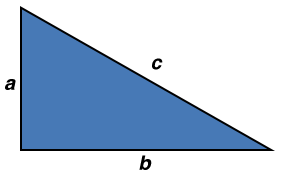
According to the Pythagorean Theorem, a right triangle has two leg lengths, a, and b, and a hypotenuse length, c, such that a2 + b2 = c2.

You may have already encountered special sets of whole numbers, a, b, and c, that make the Pythagorean relationship true. In this resource, you will investigate different sets of those special numbers, and look for patterns in the sets.
Those sets of numbers are called Pythagorean triples, because they are three numbers that make the Pythagorean relationship true.
The following applet will allow you to drag the orange points along the grid to generate different Pythagorean triples. As you move the orange points, write down the Pythagorean triples you discover. Right click to use larger triangles.

![]() Pythagorean Triples
Pythagorean Triples
(This link will open a new window/tab in your browser. Close the window/tab to return to this lesson)
Using your own paper, draw a table like the one shown below. Record the Pythagorean triples in your table.
What patterns do you observe in this set of values? Write down your findings next to your table.
a |
b |
c |
3 |
4 |
5 |